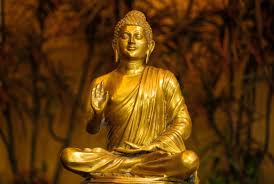
Buddhisim
1 Buddhist Art and Architecture History of Art I
4 Jocho, Buddha (Amida Nyorai), c. 1000 AD
5 Siddartha Gautama, c. 500 BC
6 Eightfold Path
7 Iconography
10 An architecture of restraint The Great Stupa of Sanchi, c. 100 BC
14 Borobudur, Java, 800 AD Largest Buddhist monument in the world
16 Symbolized Mount Meru, home of the gods in Indian mythology
18 Lava stone, dry construction
19 Mandala Eight levels to symbolize the eightfold path to enlightenment
22 Relief panels (Over 2,600 ring the monument) On the first tier, the causes of human suffering
23 Panels read clockwise; each tier begins and ends at the eastern gate
25 Tribhanga Pose Life of Siddartha Gautama panels
27 As you ascend the decoration becomes more simple (pure)
29 Literally elevated
31 Phoenix Hall, Kyoto Japan, c. 1000 AD
32 Jocho, Buddha (Amida Nyorai), c. 1000 AD
33 1) Location on “island”
34 2)The weightlessness of nirvana
35 Material? Construction?
36 Bracket set
Buddhist art 1
- 1. Solis, Miguel Art 160
- 2. Buddhism was introduced to Japan in the mid-sixth century, when Seong of Baekje sent a statue of Buddha to Emporer Kimmei
- 3. This is the oldest sculpture of Buddha in Japan, though it has survived many years due to earthquakes and other causes some of the sculpture is damaged. By :Kuratsukuri-no-Tori 609 AC
- 4. Known as the Five Great Buddhas. Are representations of the five qualities of Buddha. They are the primary object of worship meditation in Shingon Buddhism.
- 5. Known as the supreme Buddha. Represents the wisdom of emptiness. He is placed at the center of all five Buddhas. The image shows high concentration and tranquility. The flowers and the meditation gives a very peaceful vibe. Vairocana is white representing all colors.
- 6. The Dhyani Buddha Akshobhya', Tibetan thangka, late 13th century, Honolulu Museum of Art. Made in the late 13th century. Akshobhya known as the immovable one, represents consciousness as an aspect of reality. The bright red and dark image give it a very powerful look. Akshobhvya helps you distinguish reality and illusions in your mind.
- 7. Also known as infinite light. He is the Buddha in the Pure Land where everyone enjoys endless happiness. Many call upon Amitabha before dying hoping to join him after death. west side of Borobudur, ca. 1863- 1866 By: van Kinsbergen
- 8. Represents feeling or sensation and its relationship with consciousness. Develops equality and helps eliminate greed and pride. Normally is colored in yellow or gold, his element is earth and his Buddha field is Śrimat. His emblem is the ratna jewel, symbolizing the Bodhicitta, the highest value of the Buddhist
- 9. He known as the Lord of Karma and the Buddha of unfailing accomplishment. His name literally means high success. He is the Buddha of fearlessness and all wisdom. He is normally in green and radiating green light as the color represents peace and tranquility of nature. He helps eliminate envy, anxiety, and fear.
- 10. http://en.wikipedia.org/wiki/File:Asuka_dera_d aibutsu.jpg Http://en.wikipedia.org/wiki/Five_Dhyani_Bud dhas http://en.wikipedia.org/wiki/File:BuddhaLoutsS m.jpg http://en.wikipedia.org/wiki/Akshobhya http://www.britannica.com/EBchecked/topic/20 850/Amitabha http://www.manjushri.com/Buddha- List/Ratnasambhava.html http://tsl.org/2013/11/amoghasiddhi-dhyani- buddha/










